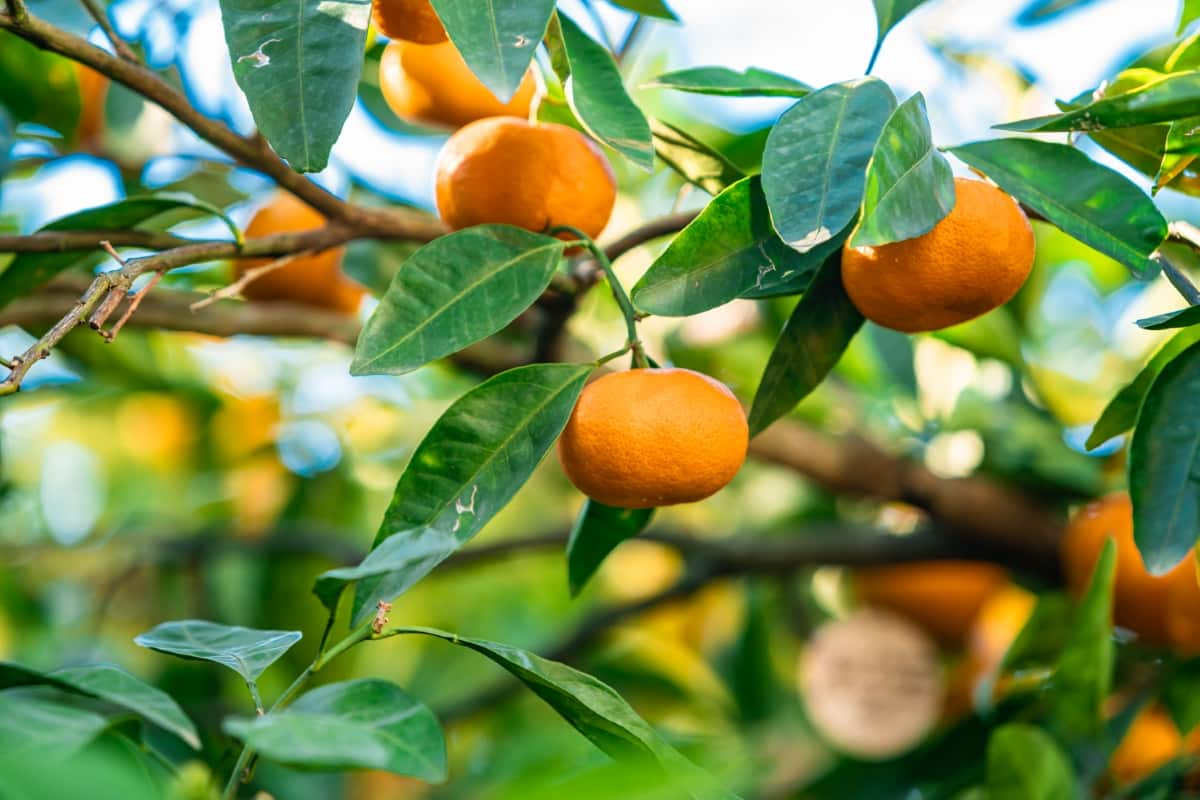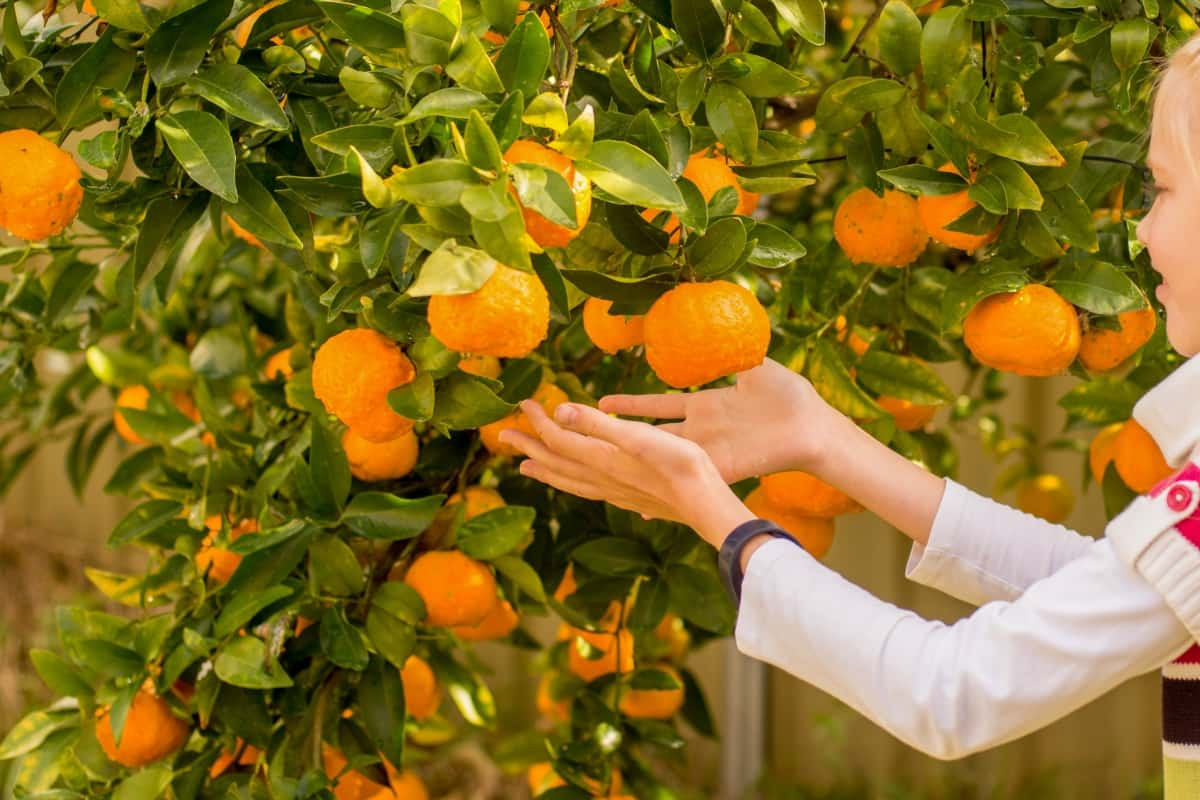Satsuma mandarin, a citrus fruit, originated in Japan. Historically associated with the Kagoshima prefecture, Satsumas are now cultivated globally in regions with warm climates. With a distinctive thin, smooth skin and vibrant orange color, Satsumas are a favorite in winter, offering a refreshing, tangy-sweet flavor.

The Satsuma Mandarin tree size is about 15 feet tall, while the dwarf Satsuma Mandarin counterpart grows to about 6-8 feet. This mandarin variety has become a cherished citrus staple worldwide. In this exploration, we’ll delve into the origin, history, cultivation, and interesting facts surrounding the Satsuma mandarin.
All You Need to Know About Satsuma Mandarin
The Origin and History of Satsuma Mandarins
Satsuma mandarins, originating from Japan, trace their roots to the 14th century. Named after the Satsuma province, these citrus fruits gained worldwide popularity in the 19th century. Introduced to the United States in the late 19th century, they found a favorable climate in California, becoming a prominent crop.
Known for their easy-to-peel skin and sweet, seedless segments, Satsumas are a favorite winter citrus. The fruit’s resilience to colder temperatures contributes to its success in various regions. Today, Satsuma mandarins are cherished for their rich history, delightful flavor, and widespread cultivation, embodying centuries of cultivation and cross-cultural exchange.
Nutritional Facts of Satsuma Mandarins
- Calories: Satsuma mandarins are low in calories, with approximately 47 calories per 100 grams.
- Carbohydrates: They are the best source of carbohydrates, providing around 12 grams per 100 grams.
- Fiber: Satsumas contain dietary fiber, contributing to digestive health with about 1.8 grams per 100 grams.
- Vitamins: Rich in vitamin C, one of the key antioxidants supporting immune function and skin health.
- Minerals: Satsumas provide minerals like potassium, which is essential for heart health, with around 166 mg per 100 grams.
- Hydration: With high water content, they contribute to hydration, which is vital for overall well-being.
- Low Fat: They are low in fat, making them a healthy snack option.
Satsuma Mandarins vs. Other Citrus Fruits
Satsuma mandarins, a type of citrus fruit, distinguish themselves with a sweet, easy-to-peel, and seedless nature. Their vibrant, loose skin sets them apart from other citrus varieties. Satsumas offer a delicate balance of sweetness and acidity, making them a popular choice for snacking and juicing. Unlike oranges, they lack bitterness and have a distinctive zipper-like skin that simplifies consumption.
While satsumas share similarities with clementines, their flavor profile is subtly different. In comparison to citrus fruits, satsumas are notably smaller and less tart. Ultimately, Satsuma mandarins stand out for their convenience, appealing taste, and distinctive peel, making them a delightful addition to the citrus spectrum.
Satsuma Vs. Mandarin
Satsuma is a type of mandarin orange known for its loose, easy-to-peel skin, sweet flavor, and seedless nature. While all Satsumas are mandarins, not all mandarins are Satsumas. Satsumas, originally from Japan, are a specific cultivar within the mandarin category, prized for their unique taste, vibrant orange hue, and convenient peeling. The terms are often used interchangeably, but Satsumas represent a distinct variety, celebrated for their delightful balance of sweetness and acidity.
Satsuma Vs. Orange
Satsumas, a type of mandarin, are smaller, with a thin, easy-to-peel skin and a sweeter, less acidic flavor. They often lack seeds. Oranges, a broader category including varieties like navel and Valencia, have a thicker peel and larger size and can vary in sweetness and acidity. Satsumas are typically more aromatic and have a distinct tropical flair. Both fruits offer nutritional benefits, but satsumas are prized for their convenience, sweetness, and unique citrus profile compared to the more diverse family of oranges.
In case you missed it: How to Prevent Orange Fruit Rot Naturally: How to Control with Natural and Organic Treatment

Ideal Conditions for Growing Satsuma Mandarins
- Satsuma mandarins thrive in well-drained, sandy-loam soil with an acidic to neutral pH range between 6.0 and 7.5.
- Ideal temperatures range from 13-29°C, with frost sensitivity below -2°C.
- Humidity should be moderate, around 50-70%. Consistent watering is crucial, maintaining soil moisture without waterlogging.
- During dry spells, provide 1-1.5 inches of water per week.
- Fertilize with a balanced and slow-release fertilizer in spring and late summer. Optimal fertilization promotes healthy growth and fruit production.
- Protect from frost and ensure good air circulation to prevent diseases.
Harvesting and Seasonal Availability of Satsuma Mandarins
Satsuma mandarins, a citrus delight, typically mature from late fall through winter. Harvesting occurs from October to December, peaking in November. Originating from Japan, these seedless, easy-to-peel fruits thrive in temperate climates. Their seasonal availability aligns with cooler temperatures, enhancing sweetness and flavor development. Satsumas are celebrated for their juicy, tangy taste and bright orange hue. As winter approaches, consumers eagerly anticipate the bountiful harvest, enjoying a burst of vitamin C and a refreshing addition to holiday festivities.
Understanding Satsuma Mandarin Sugar Content
Satsuma mandarins typically contain around 10-12 grams of sugar per medium-sized fruit (about 131 grams). The sugar content in mandarins mainly comprises natural sugars like fructose, glucose, and sucrose. While exact sugar levels may vary based on factors like ripeness and growing conditions, Satsumas are known for their sweetness and are a healthier alternative to processed snacks.
In case you missed it: Best Lemon Varieties to Grow in Your Garden

Additionally, the fruit provides essential nutrients like vitamin C and fiber, making it one of the most nutritious choices and naturally sweet choices for those looking to satisfy their sweet cravings while maintaining a balanced diet.
Satsuma Mandarin Varieties: Different Types
- Owari Satsuma: The most common type, known for its sweetness and easy peeling.
- Armstrong Satsuma: A cold-hardy variety suitable for cooler climates.
- Brown’s Select Satsuma: Similar to Owari, with a slightly different flavor profile.
- Early St. Ann Satsuma: Early ripening variety, ready for harvest in September.
- Dobashi Beni Satsuma: Distinctive red-fleshed fruit with a rich, sweet taste.
- Xie Shan Satsuma: Known for its rich, complex flavor and high sugar content.
- Okitsu Satsuma: Seedless variety with a balanced sweet-tart taste.
- Silverhill Satsuma: A late-maturing cultivar with excellent cold tolerance.
- Kimbrough Satsuma: Resistant to diseases, producing juicy and flavorful fruit.
- Miho Satsuma: A popular Japanese variety prized for its sweetness and aromatic qualities.
Pest and Disease Management in Satsuma Mandarin Orchards
- Cultural Practices: Implement proper spacing and pruning for adequate air circulation. Ensure orchard hygiene by removing fallen leaves and debris. Use disease-resistant rootstocks.
- Biological Control: Introduce beneficial insects like ladybugs for pest control. Use predatory mites to manage mite infestations.
- Chemical Control: Apply approved pesticides based on pest and disease thresholds. Rotate chemicals to minimize resistance development.
- Monitoring: Regularly inspect orchards for signs of pests and diseases. Set up pheromone traps for early detection of specific insects.
- Disease-Resistant Varieties: Choose Satsuma Mandarin varieties with inherent resistance to common diseases. Stay updated on new, disease-resistant cultivars.
- Weather Monitoring: Utilize weather data to predict and plan for potential pest and disease outbreaks. Adjust management practices based on climatic conditions.
- Post-Harvest Practices: Promptly remove and dispose of damaged or infected fruits. Sanitize harvesting equipment to prevent disease spread.
In case you missed it: Best Fertilizer for Lemons in Pots: Organic, Natural, Homemade, NPK Ratio, When and How to Apply

Conclusion
In conclusion, the Satsuma mandarin has a fascinating history rooted in Japan and has become a beloved citrus variety worldwide. Its easy cultivation, delicious flavor, and versatility in the kitchen contribute to its popularity. Whether eaten fresh, juiced, or used in culinary creations, the Satsuma mandarin continues to be a favorite among citrus enthusiasts, adding a burst of sweetness and nutrition to our lives.
- Feed Your Flock for Less: Top 10 Tips to Save on Chicken Feed
- Ultimate Guide to Ossabaw Island Hog: Breeding, Raising, Diet, and Care
- Hatching Answers: The Top 10 Reasons Your Chickens Aren’t Laying Eggs
- Eggs and Economics: Breaking Down the Cost of Raising Backyard Chickens
- Defend Your Greens: Proven Methods to Keep Iguanas Out of Your Garden
- Ultimate Guide to Cinnamon Queen Chicken: A Comprehensive Guide for Beginners
- Ultimate Guide to California Tan Chicken: Breeding, Raising, Diet, Egg-Production and Care
- Ultimate Guide to Marsh Daisy Chicken: Breeding, Raising, Diet, and Care
- 10 Types of Chicken Farming Businesses You Can Start for Profits